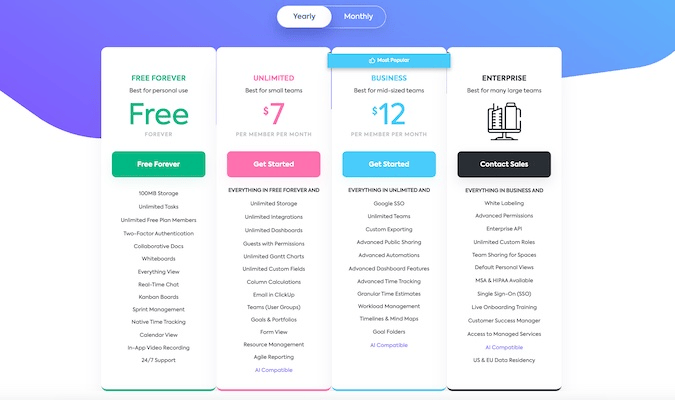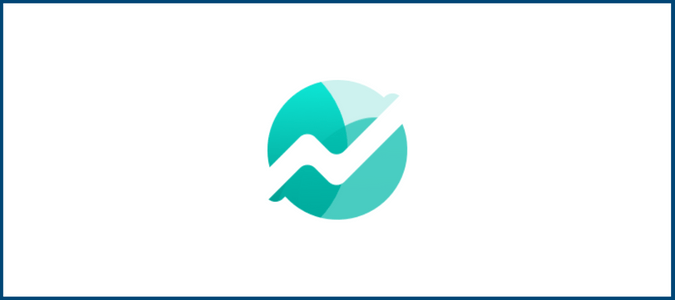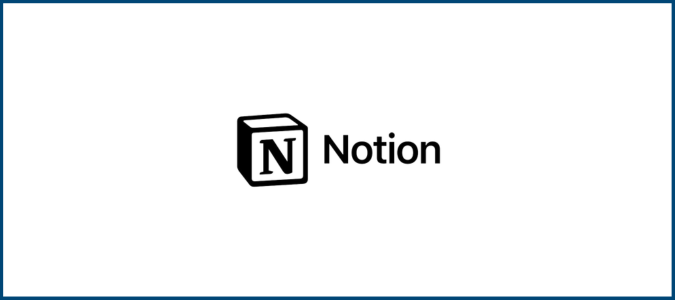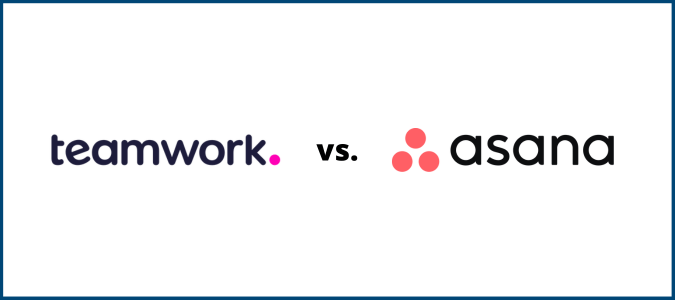Agile and waterfall are two popular project management methodologies. Each one uses their own distinctive methods to complete tasks and projects and both are useful for different use cases and project types.
Use this guide to determine whether Agile or waterfall project management is the methodology that best fits the needs of your next project.
Agile Compared to Waterfall Project Management
Agile is an iterative methodology that works best when the project constraints are not well defined. It’s a highly collaborative and flexible approach to project management, where timelines and tasks can change throughout the process. ClickUp is the best Agile project management software—and you can sign up today for free.
Waterfall project management is sequential. It’s a traditional approach to handling tasks that can be completed in a linear process. Teams can use the waterfall methodology for projects with clearly defined requirements and timelines. Try Wrike for free if you’re interested in using a PM platform that works well for waterfall project management.
More Top Agile Project Management Tools
There are lots of other project management tools on the market that support both Agile and waterfall methods. Within the Agile framework alone, there are several different variations and methodologies. Our team here at Crazy Egg conducted extensive research and testing to narrow down the field to the best Agile project management tools. See all of our top picks to learn more and find the best one for you.
Where Agile Project Management Shines
Flexibility: Agile comes to the rescue when projects are highly flexible and can change throughout the process. With the Agile method, project scope is segmented into several incremental steps (called sprints) that include stopping for feedback at regular intervals. This gives teams the opportunity to adjust, make changes, re-prioritize, and keep everyone on the same page.
Promotes collaboration: Most Agile teams meet on a daily basis for about 15 minutes to discuss their work’s progress. This gives everyone an opportunity to speak up about areas where they need help and ensure the entire team is on the same page. Agile teams also have more detailed meetings after each sprint, where they can evaluate what went well, what needs improvements, and how to adjust moving forward for the next sprint.

High chance of client satisfaction: One thing that’s unique about Agile management is stakeholder involvement. Agile provides stakeholders the opportunity to see progress, provide feedback, and make changes throughout the project. This keeps them informed and ensures they aren’t surprised with the final product—keeping satisfaction levels higher than other project management methods.
Identify problems early: This approach we’ve touched on above gives team members, project managers, and stakeholders the ability to quickly identify issues as early as possible. Since most tasks aren’t dependent on others, you won’t be limited to spotting potential flaws with the plan months down the road. Due to the flexibility of Agile projects, it’s easy to make any appropriate changes once a potential problem has been identified.
Software development: Agile project management is the preferred methodology for software teams. If you’re creating mobile applications, custom web apps, SaaS, or any other IT project, Agile will almost always be the best method for your team. There’s also a good chance that your software team has experience using this methodology for projects they’ve completed in the past.
High productivity and efficiency: Agile teams typically work in two-week sprints. These periods encourage everyone to work quickly, completing as many tasks and deliverables as possible during each phase. It’s much less intimidating to look at a project in two-week intervals than a year-long timeline.

Where Agile Project Management Falls Short
Reliant on client involvement: The high degree of client involvement could potentially cause headaches for certain project teams. Some stakeholders are disinterested and may not have the time to participate. Other stakeholders are high maintenance and constantly criticize or repeatedly request changes. These situations aren’t fun for project managers or their teams.
Extended timelines: Quick turnaround on deliverables and frequent changes in priority can lead to projects taking longer than initially expected. Since teams aren’t actually forced to complete specific tasks within a sprint, additional sprints may be required if the workload at each stage is too heavy for the team.
Added cost: Timeline extensions almost always translate to increased costs. Not only are you paying more for labor and resources, but you might also have to pay more for changes to the project scope. For example, stakeholders may request another feature to be added to a software product midway through the project.
Reliant on effective teamwork: Agile projects typically don’t finish well if the project team isn’t working cohesively. There must be continuous and effective collaboration on a daily basis for this methodology to work the way it’s intended. If teams don’t know how to provide effective feedback and take criticism without being offended, it could create friction amongst the team—adversely affecting the final product.
Where Waterfall Project Management Shines
Clearly established goals and expectations: There aren’t many surprises in waterfall project management. Teams follow a concrete plan of action from the very beginning of the project and ensure that plan gets executed until the project is completed. No changes to the scope, tasks, or process are changed once the project begins in earnest.
Easy to Follow and Implement: Waterfall project management is straightforward compared to other methodologies. Project managers and teams can clearly understand the way it works, even if they don’t have any experience with this type of management framework. There’s virtually no learning curve, so teams can get straight to work.

Fixed budgets: The project budget should remain unchanged throughout a project managed with the waterfall method. Stakeholders and project managers alike know exactly what they’re getting into and don’t have to worry about unexpected costs along the way. This is significantly different from Agile projects, which can easily go over budget as changes are made to the project scope.
Easy to measure progress: Project managers have a much easier time monitoring the progress and productivity of teams utilizing waterfall PM. They can quickly see whether or not tasks are being completed on time for specific milestones and if the overall progress to completion is on track.
Easy to scale: The waterfall project management methodology is much easier to scale compared to other methods, whereas Agile projects are best for smaller teams. But with waterfall, you can easily apply the same concepts to teams of five or teams of 20. In a sense, the same approach you use to build a shed can be used to build an apartment complex.
Clean transfer of information: Waterfall project management is methodical. As a result, information, documentation, and status are clearly transferred from one step to another. So, if personnel changes during the project, any new team members can quickly get up to speed using the information at their disposal.

Where Waterfall Project Management Falls Short
Tasks are dependent on each other: Since waterfall project management is sequential, a single delay or speed bump can impact the entire project. Let’s say you’re managing something very simple, like a blog content calendar. Blogs can’t be published until they’re edited, and they can’t be edited until they’re written. So a delay in the writing process can create knock-on delays in editing and publishing.That can happen, too, in a waterfall project if an early-stage task experiences a delay.
Harder to identify issues: Waterfall project management teams may not discover an issue or problem with a phase until they’ve already progressed to the next one. When this happens, it could force them to go back and make the appropriate fixes before progressing—derailing productivity and potentially adding to the project cost.
No flexibility: Each stage of the project is outlined in detail from the very beginning. Everyone knows what’s expected of them from start to finish. While this approach is simple, it does not allow for much flexibility or change once the project begins. This means that the success or failure of a project could boil down to how the initial planning process went.
Low stakeholder involvement: Beyond the planning stage, stakeholders are not really involved with the project. Project managers will likely provide them with updates at certain milestones, but they’re not collaborating or providing feedback during the process. This can be problematic if there’s a communication gap between the client’s expectations and the team’s vision.
The Final Verdict on Agile Compared to Waterfall Project Management
Agile and waterfall project management methods are not interchangeable. One can’t definitively be crowned the best, as they each work well for unique scenarios.
Waterfall project management is better for projects with fixed timelines and fixed budgets. All tasks and goals are clearly mapped out and established from the very beginning. Once those goals are established, clients or project owners are not part of the process.
That makes Waterfall more structured and predictable. It’s commonly used in construction projects, where everything is very linear. The foundation must be in place before you can frame the walls, and the walls must be framed before you can put on the roof.
Agile projects are much more flexible. It’s highly collaborative between team members, as well as clients or stakeholders. They can provide feedback and suggest changes during the process. Agile projects do not have fixed deadlines or budgets, and teams typically work in shorter sprints for deliverables.
The Agile methodology is most commonly used for IT companies and software development. Teams can move quickly and work on parallel parts of the project in different phases.
ClickUp is our top recommendation for project managers and teams using Agile frameworks. It’s trusted by over 800,000 teams across categories like software development, engineering, marketing, human resources, and operations.
Regardless of your team size, you can find a ClickUp plan that supports your needs.

The free-forever plan is a great way to get a feel for the software. But if you’re serious about using it to manage project teams, you should definitely upgrade to the Unlimited plan.
Starting at just $7 per user per month, it’s an amazing value for everything you need to manage an Agile project. You’re better off upgrading to a Business or Enterprise plan if you need to run multiple Agile projects simultaneously with different teams and project managers.
Wrike is an excellent option for linear projects and waterfall management. It comes with Gantt charts, Kanban boards, pre-built workflows, and automated approval processes. The software works great for things like event management, client or employee onboarding, and product delivery—all of which require sequential steps.
With plans starting at just $9.80 per user per month and a free-forever plan for task management, Wrike is super affordable when you consider how feature-packed the software is.

The free plan comes with 2 GB of storage, internal and external collaborators, interactive boards and spreadsheets, account-wide scheduling, and integrations with cloud storage solutions. Interactive Gantt charts aren’t available until you reach the Professional tier.
At $24.80 per user per month, the Business plan is at a slightly higher price point compared to similar solutions on the market. However, it leaves nothing out—you’re getting everything you could possibly need to manage waterfall projects at scale.
The Business plan comes with custom workflows, real-time reporting, request forms, resource management, time tracking, workload charts, user and group permissions, and more. All of these features make it easy for both project managers and teams to ensure projects are being completed on time and under budget.
If you’re looking for some alternative solutions to manage your Agile or waterfall projects, you don’t have to choose between ClickUp and Wrike alone. We’ve identified the top six tools on the market to help you find the perfect one for your unique needs. See our full reviews to find the best option for you.
- ClickUp – Best Agile project management tool for most
- Monday.com – Best lifeline for Agile team collaboration
- Jira Software – Best free forever Agile project management tool
- Trello – Best for achieving Agile project management mastery overnight
- Asana – Best for automating the routine work you hate
- Teamwork – Best all-in-one Agile project management tool















